Auditing and Assurance Services: Assertion Risks and ASA 701 Report
VerifiedAdded on 2021/09/16
|13
|2796
|85
Report
AI Summary
This report delves into the realm of auditing and assurance services, analyzing the risks associated with management assertions within financial statements. The report examines two case studies: Computing Solutions Limited and Beautiful Hair Limited. For Computing Solutions, the report identifies completeness and accuracy as key assertion risks, detailing the substantive procedures auditors can employ to mitigate these risks, including reconciliation and observation. It also discusses the application of ASA 701 in communicating key audit matters. The second case study, Beautiful Hair Limited, focuses on ownership and occurrence as critical assertions, outlining related audit procedures such as examining title documents. The report emphasizes the importance of ASA 701 in identifying and communicating key audit matters and the implications of assertion risks on financial reporting, highlighting the auditor's responsibilities in disclosing these risks and the applied audit techniques. The report offers a comprehensive overview of auditing practices and the crucial role of auditors in ensuring the accuracy and reliability of financial information.

Running head: AUDITING AND ASSURANCE SERVICES
Auditing and Assurance Services
Name of the Student
Name of the University
Author’s Note
Auditing and Assurance Services
Name of the Student
Name of the University
Author’s Note
Paraphrase This Document
Need a fresh take? Get an instant paraphrase of this document with our AI Paraphraser
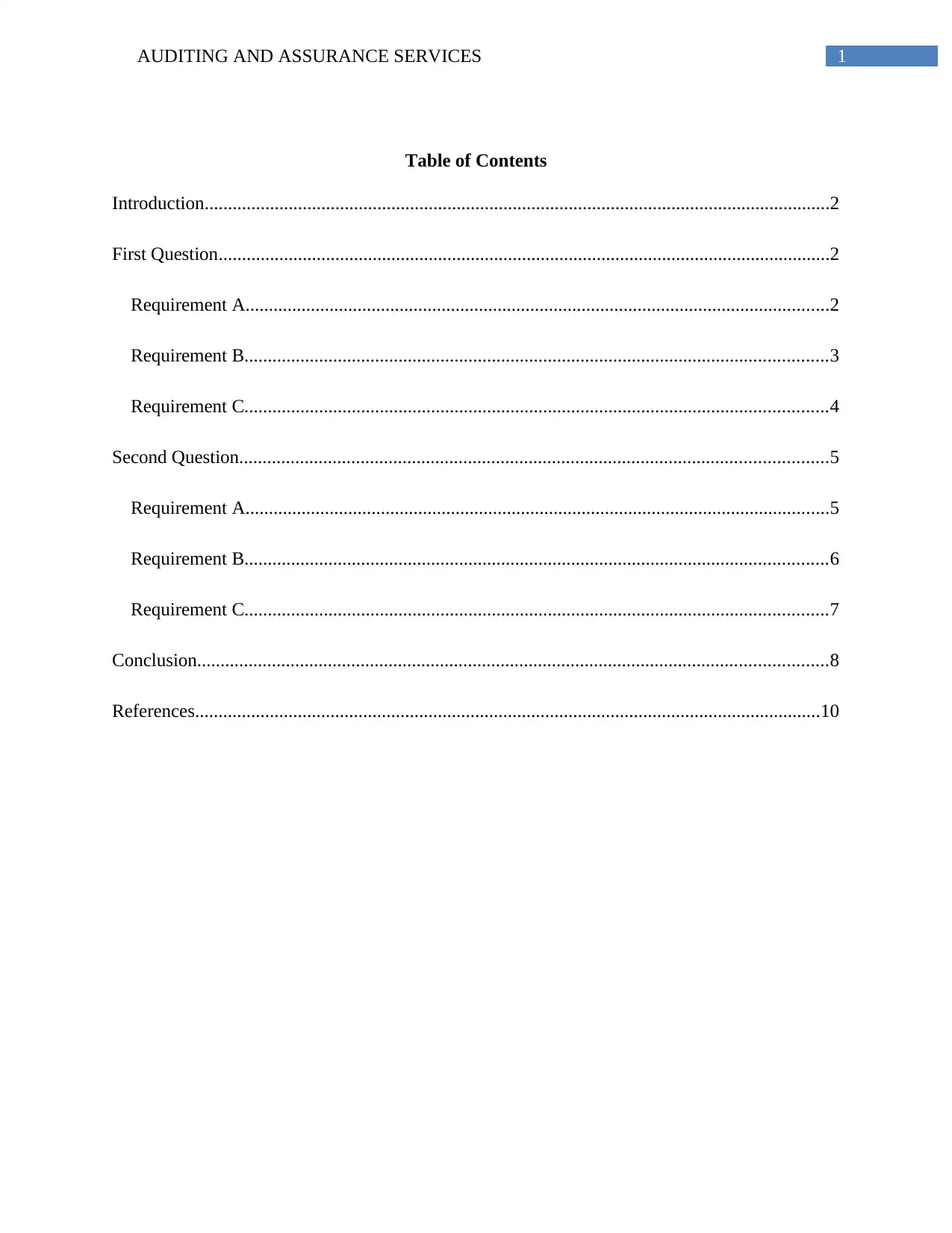
1AUDITING AND ASSURANCE SERVICES
Table of Contents
Introduction......................................................................................................................................2
First Question...................................................................................................................................2
Requirement A.............................................................................................................................2
Requirement B.............................................................................................................................3
Requirement C.............................................................................................................................4
Second Question..............................................................................................................................5
Requirement A.............................................................................................................................5
Requirement B.............................................................................................................................6
Requirement C.............................................................................................................................7
Conclusion.......................................................................................................................................8
References......................................................................................................................................10
Table of Contents
Introduction......................................................................................................................................2
First Question...................................................................................................................................2
Requirement A.............................................................................................................................2
Requirement B.............................................................................................................................3
Requirement C.............................................................................................................................4
Second Question..............................................................................................................................5
Requirement A.............................................................................................................................5
Requirement B.............................................................................................................................6
Requirement C.............................................................................................................................7
Conclusion.......................................................................................................................................8
References......................................................................................................................................10
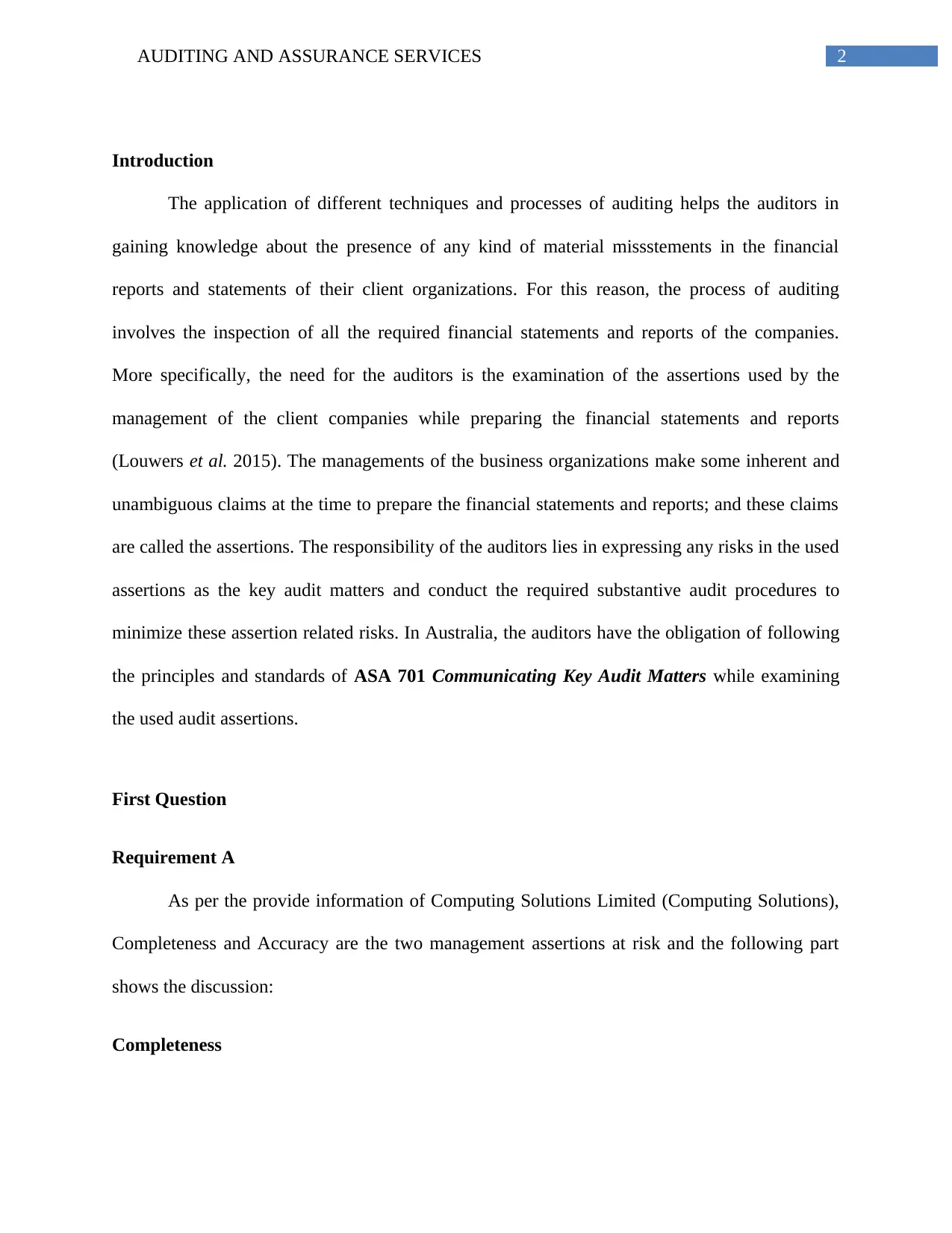
2AUDITING AND ASSURANCE SERVICES
Introduction
The application of different techniques and processes of auditing helps the auditors in
gaining knowledge about the presence of any kind of material missstements in the financial
reports and statements of their client organizations. For this reason, the process of auditing
involves the inspection of all the required financial statements and reports of the companies.
More specifically, the need for the auditors is the examination of the assertions used by the
management of the client companies while preparing the financial statements and reports
(Louwers et al. 2015). The managements of the business organizations make some inherent and
unambiguous claims at the time to prepare the financial statements and reports; and these claims
are called the assertions. The responsibility of the auditors lies in expressing any risks in the used
assertions as the key audit matters and conduct the required substantive audit procedures to
minimize these assertion related risks. In Australia, the auditors have the obligation of following
the principles and standards of ASA 701 Communicating Key Audit Matters while examining
the used audit assertions.
First Question
Requirement A
As per the provide information of Computing Solutions Limited (Computing Solutions),
Completeness and Accuracy are the two management assertions at risk and the following part
shows the discussion:
Completeness
Introduction
The application of different techniques and processes of auditing helps the auditors in
gaining knowledge about the presence of any kind of material missstements in the financial
reports and statements of their client organizations. For this reason, the process of auditing
involves the inspection of all the required financial statements and reports of the companies.
More specifically, the need for the auditors is the examination of the assertions used by the
management of the client companies while preparing the financial statements and reports
(Louwers et al. 2015). The managements of the business organizations make some inherent and
unambiguous claims at the time to prepare the financial statements and reports; and these claims
are called the assertions. The responsibility of the auditors lies in expressing any risks in the used
assertions as the key audit matters and conduct the required substantive audit procedures to
minimize these assertion related risks. In Australia, the auditors have the obligation of following
the principles and standards of ASA 701 Communicating Key Audit Matters while examining
the used audit assertions.
First Question
Requirement A
As per the provide information of Computing Solutions Limited (Computing Solutions),
Completeness and Accuracy are the two management assertions at risk and the following part
shows the discussion:
Completeness
⊘ This is a preview!⊘
Do you want full access?
Subscribe today to unlock all pages.

Trusted by 1+ million students worldwide
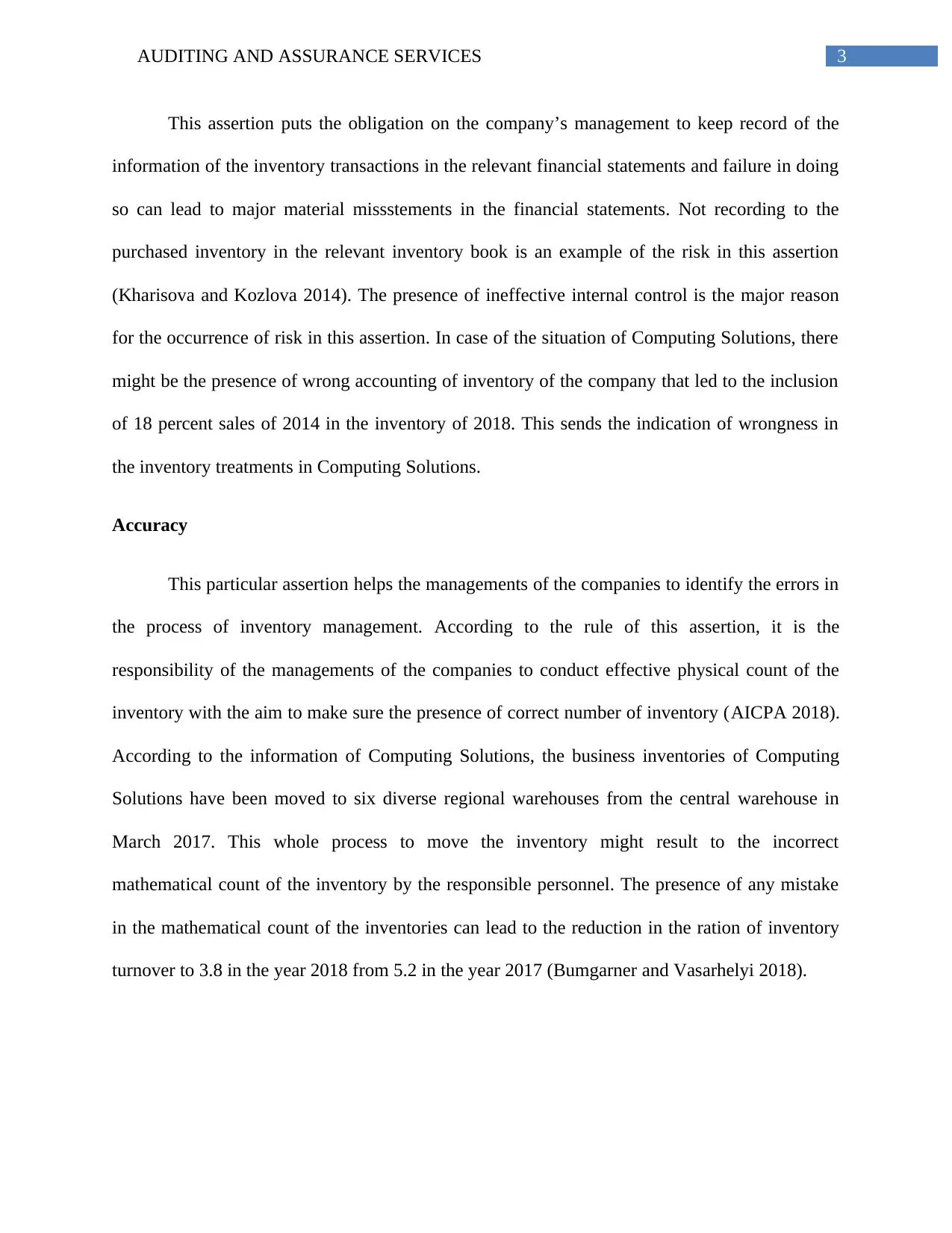
3AUDITING AND ASSURANCE SERVICES
This assertion puts the obligation on the company’s management to keep record of the
information of the inventory transactions in the relevant financial statements and failure in doing
so can lead to major material missstements in the financial statements. Not recording to the
purchased inventory in the relevant inventory book is an example of the risk in this assertion
(Kharisova and Kozlova 2014). The presence of ineffective internal control is the major reason
for the occurrence of risk in this assertion. In case of the situation of Computing Solutions, there
might be the presence of wrong accounting of inventory of the company that led to the inclusion
of 18 percent sales of 2014 in the inventory of 2018. This sends the indication of wrongness in
the inventory treatments in Computing Solutions.
Accuracy
This particular assertion helps the managements of the companies to identify the errors in
the process of inventory management. According to the rule of this assertion, it is the
responsibility of the managements of the companies to conduct effective physical count of the
inventory with the aim to make sure the presence of correct number of inventory (AICPA 2018).
According to the information of Computing Solutions, the business inventories of Computing
Solutions have been moved to six diverse regional warehouses from the central warehouse in
March 2017. This whole process to move the inventory might result to the incorrect
mathematical count of the inventory by the responsible personnel. The presence of any mistake
in the mathematical count of the inventories can lead to the reduction in the ration of inventory
turnover to 3.8 in the year 2018 from 5.2 in the year 2017 (Bumgarner and Vasarhelyi 2018).
This assertion puts the obligation on the company’s management to keep record of the
information of the inventory transactions in the relevant financial statements and failure in doing
so can lead to major material missstements in the financial statements. Not recording to the
purchased inventory in the relevant inventory book is an example of the risk in this assertion
(Kharisova and Kozlova 2014). The presence of ineffective internal control is the major reason
for the occurrence of risk in this assertion. In case of the situation of Computing Solutions, there
might be the presence of wrong accounting of inventory of the company that led to the inclusion
of 18 percent sales of 2014 in the inventory of 2018. This sends the indication of wrongness in
the inventory treatments in Computing Solutions.
Accuracy
This particular assertion helps the managements of the companies to identify the errors in
the process of inventory management. According to the rule of this assertion, it is the
responsibility of the managements of the companies to conduct effective physical count of the
inventory with the aim to make sure the presence of correct number of inventory (AICPA 2018).
According to the information of Computing Solutions, the business inventories of Computing
Solutions have been moved to six diverse regional warehouses from the central warehouse in
March 2017. This whole process to move the inventory might result to the incorrect
mathematical count of the inventory by the responsible personnel. The presence of any mistake
in the mathematical count of the inventories can lead to the reduction in the ration of inventory
turnover to 3.8 in the year 2018 from 5.2 in the year 2017 (Bumgarner and Vasarhelyi 2018).
Paraphrase This Document
Need a fresh take? Get an instant paraphrase of this document with our AI Paraphraser
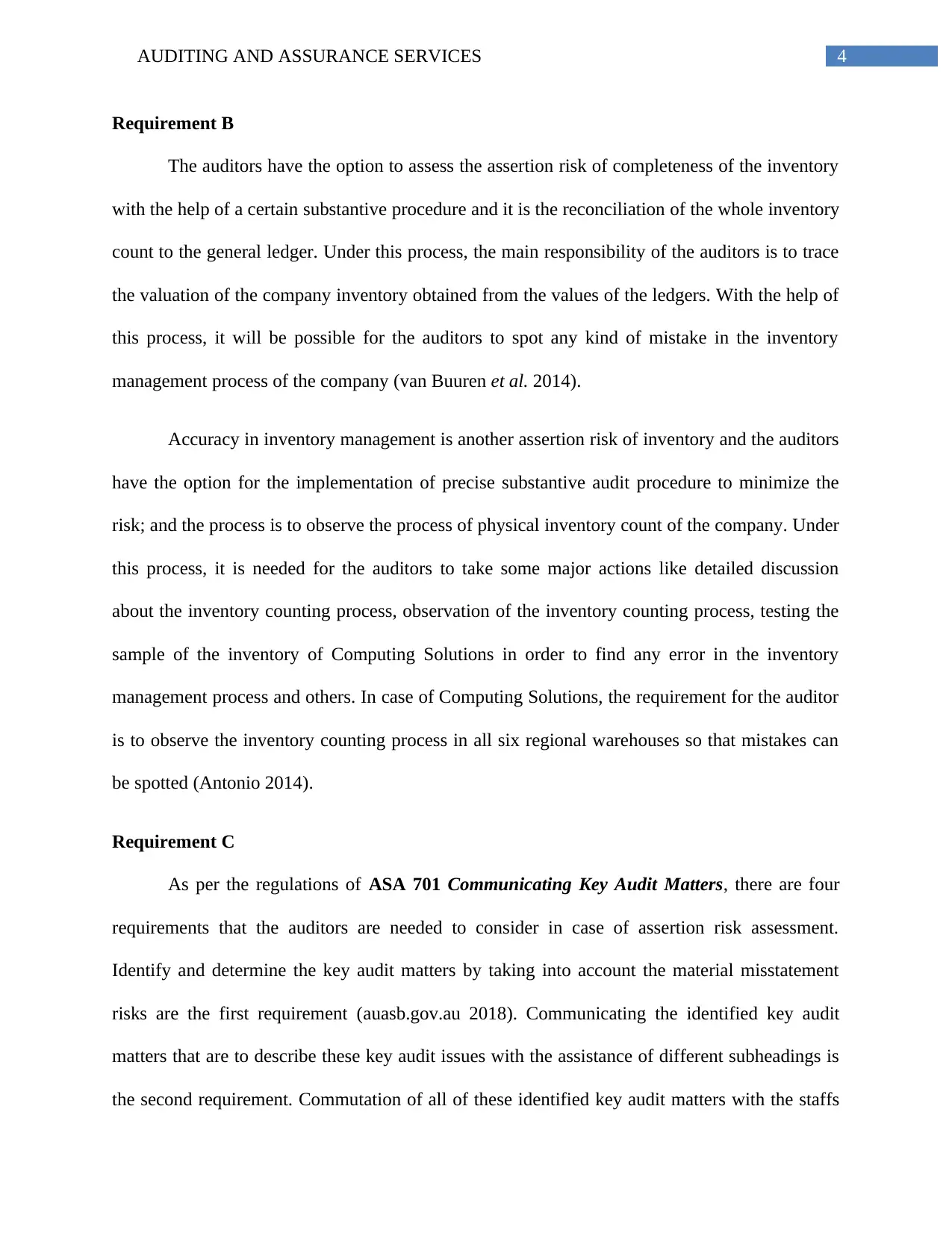
4AUDITING AND ASSURANCE SERVICES
Requirement B
The auditors have the option to assess the assertion risk of completeness of the inventory
with the help of a certain substantive procedure and it is the reconciliation of the whole inventory
count to the general ledger. Under this process, the main responsibility of the auditors is to trace
the valuation of the company inventory obtained from the values of the ledgers. With the help of
this process, it will be possible for the auditors to spot any kind of mistake in the inventory
management process of the company (van Buuren et al. 2014).
Accuracy in inventory management is another assertion risk of inventory and the auditors
have the option for the implementation of precise substantive audit procedure to minimize the
risk; and the process is to observe the process of physical inventory count of the company. Under
this process, it is needed for the auditors to take some major actions like detailed discussion
about the inventory counting process, observation of the inventory counting process, testing the
sample of the inventory of Computing Solutions in order to find any error in the inventory
management process and others. In case of Computing Solutions, the requirement for the auditor
is to observe the inventory counting process in all six regional warehouses so that mistakes can
be spotted (Antonio 2014).
Requirement C
As per the regulations of ASA 701 Communicating Key Audit Matters, there are four
requirements that the auditors are needed to consider in case of assertion risk assessment.
Identify and determine the key audit matters by taking into account the material misstatement
risks are the first requirement (auasb.gov.au 2018). Communicating the identified key audit
matters that are to describe these key audit issues with the assistance of different subheadings is
the second requirement. Commutation of all of these identified key audit matters with the staffs
Requirement B
The auditors have the option to assess the assertion risk of completeness of the inventory
with the help of a certain substantive procedure and it is the reconciliation of the whole inventory
count to the general ledger. Under this process, the main responsibility of the auditors is to trace
the valuation of the company inventory obtained from the values of the ledgers. With the help of
this process, it will be possible for the auditors to spot any kind of mistake in the inventory
management process of the company (van Buuren et al. 2014).
Accuracy in inventory management is another assertion risk of inventory and the auditors
have the option for the implementation of precise substantive audit procedure to minimize the
risk; and the process is to observe the process of physical inventory count of the company. Under
this process, it is needed for the auditors to take some major actions like detailed discussion
about the inventory counting process, observation of the inventory counting process, testing the
sample of the inventory of Computing Solutions in order to find any error in the inventory
management process and others. In case of Computing Solutions, the requirement for the auditor
is to observe the inventory counting process in all six regional warehouses so that mistakes can
be spotted (Antonio 2014).
Requirement C
As per the regulations of ASA 701 Communicating Key Audit Matters, there are four
requirements that the auditors are needed to consider in case of assertion risk assessment.
Identify and determine the key audit matters by taking into account the material misstatement
risks are the first requirement (auasb.gov.au 2018). Communicating the identified key audit
matters that are to describe these key audit issues with the assistance of different subheadings is
the second requirement. Commutation of all of these identified key audit matters with the staffs
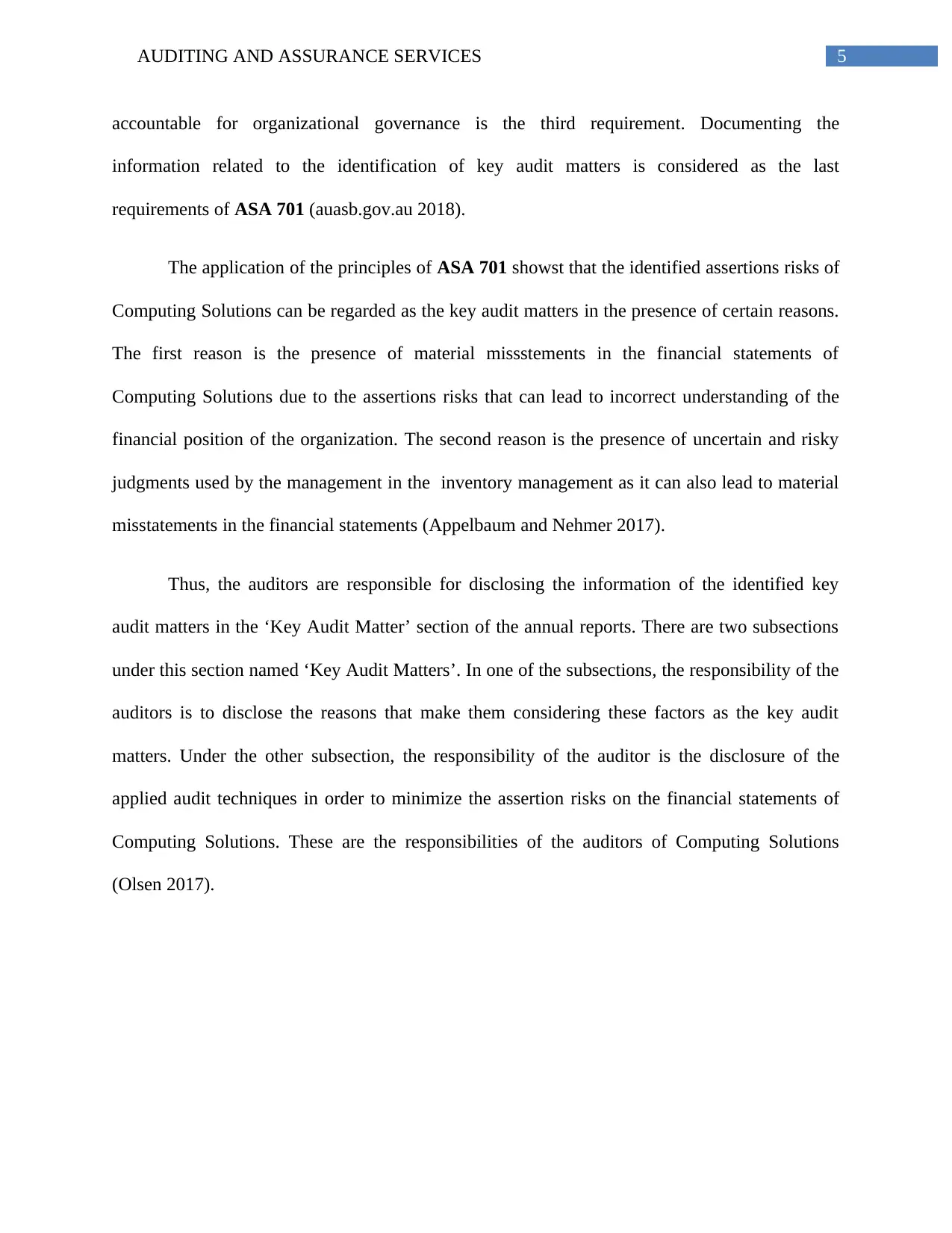
5AUDITING AND ASSURANCE SERVICES
accountable for organizational governance is the third requirement. Documenting the
information related to the identification of key audit matters is considered as the last
requirements of ASA 701 (auasb.gov.au 2018).
The application of the principles of ASA 701 showst that the identified assertions risks of
Computing Solutions can be regarded as the key audit matters in the presence of certain reasons.
The first reason is the presence of material missstements in the financial statements of
Computing Solutions due to the assertions risks that can lead to incorrect understanding of the
financial position of the organization. The second reason is the presence of uncertain and risky
judgments used by the management in the inventory management as it can also lead to material
misstatements in the financial statements (Appelbaum and Nehmer 2017).
Thus, the auditors are responsible for disclosing the information of the identified key
audit matters in the ‘Key Audit Matter’ section of the annual reports. There are two subsections
under this section named ‘Key Audit Matters’. In one of the subsections, the responsibility of the
auditors is to disclose the reasons that make them considering these factors as the key audit
matters. Under the other subsection, the responsibility of the auditor is the disclosure of the
applied audit techniques in order to minimize the assertion risks on the financial statements of
Computing Solutions. These are the responsibilities of the auditors of Computing Solutions
(Olsen 2017).
accountable for organizational governance is the third requirement. Documenting the
information related to the identification of key audit matters is considered as the last
requirements of ASA 701 (auasb.gov.au 2018).
The application of the principles of ASA 701 showst that the identified assertions risks of
Computing Solutions can be regarded as the key audit matters in the presence of certain reasons.
The first reason is the presence of material missstements in the financial statements of
Computing Solutions due to the assertions risks that can lead to incorrect understanding of the
financial position of the organization. The second reason is the presence of uncertain and risky
judgments used by the management in the inventory management as it can also lead to material
misstatements in the financial statements (Appelbaum and Nehmer 2017).
Thus, the auditors are responsible for disclosing the information of the identified key
audit matters in the ‘Key Audit Matter’ section of the annual reports. There are two subsections
under this section named ‘Key Audit Matters’. In one of the subsections, the responsibility of the
auditors is to disclose the reasons that make them considering these factors as the key audit
matters. Under the other subsection, the responsibility of the auditor is the disclosure of the
applied audit techniques in order to minimize the assertion risks on the financial statements of
Computing Solutions. These are the responsibilities of the auditors of Computing Solutions
(Olsen 2017).
⊘ This is a preview!⊘
Do you want full access?
Subscribe today to unlock all pages.

Trusted by 1+ million students worldwide
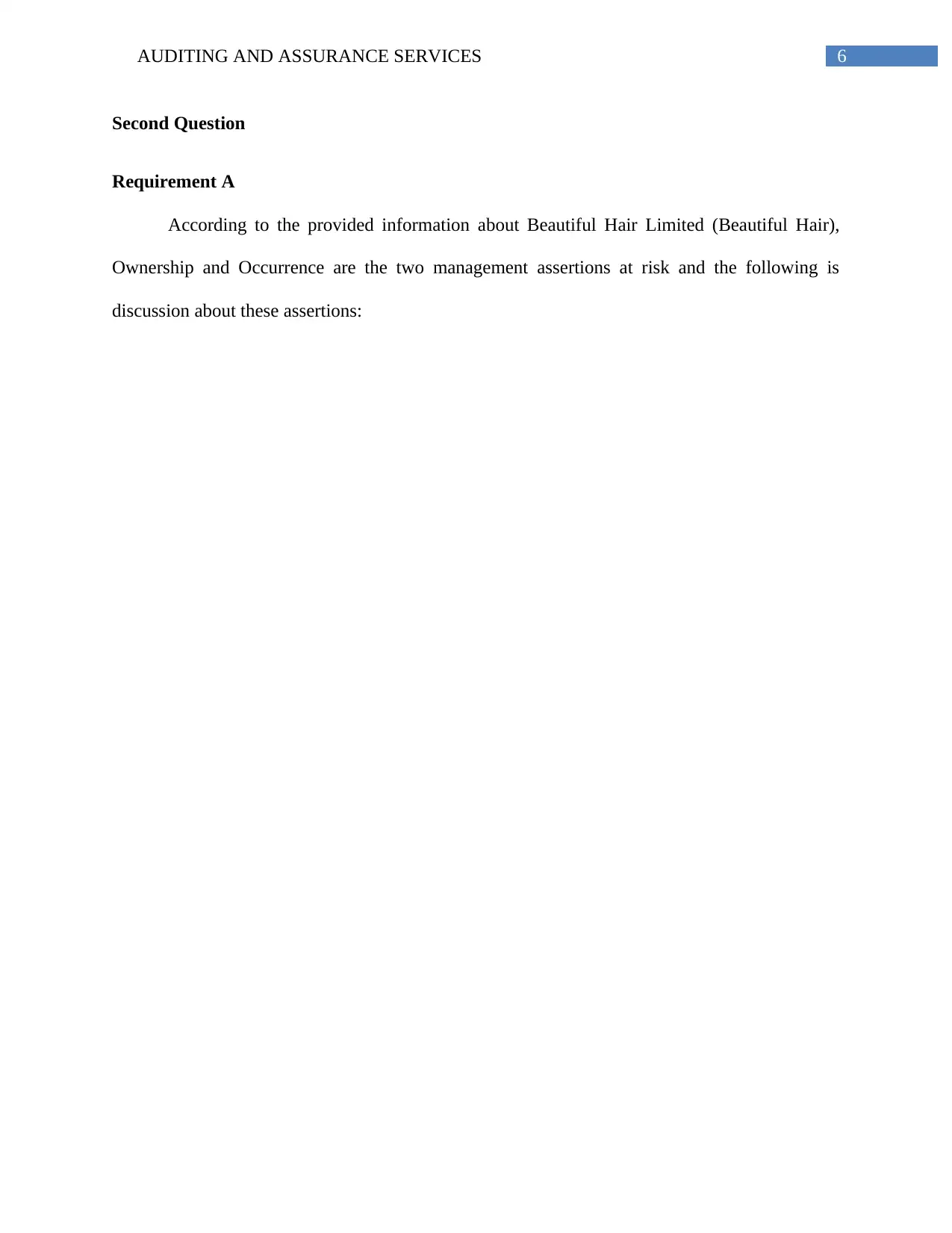
6AUDITING AND ASSURANCE SERVICES
Second Question
Requirement A
According to the provided information about Beautiful Hair Limited (Beautiful Hair),
Ownership and Occurrence are the two management assertions at risk and the following is
discussion about these assertions:
Second Question
Requirement A
According to the provided information about Beautiful Hair Limited (Beautiful Hair),
Ownership and Occurrence are the two management assertions at risk and the following is
discussion about these assertions:
Paraphrase This Document
Need a fresh take? Get an instant paraphrase of this document with our AI Paraphraser
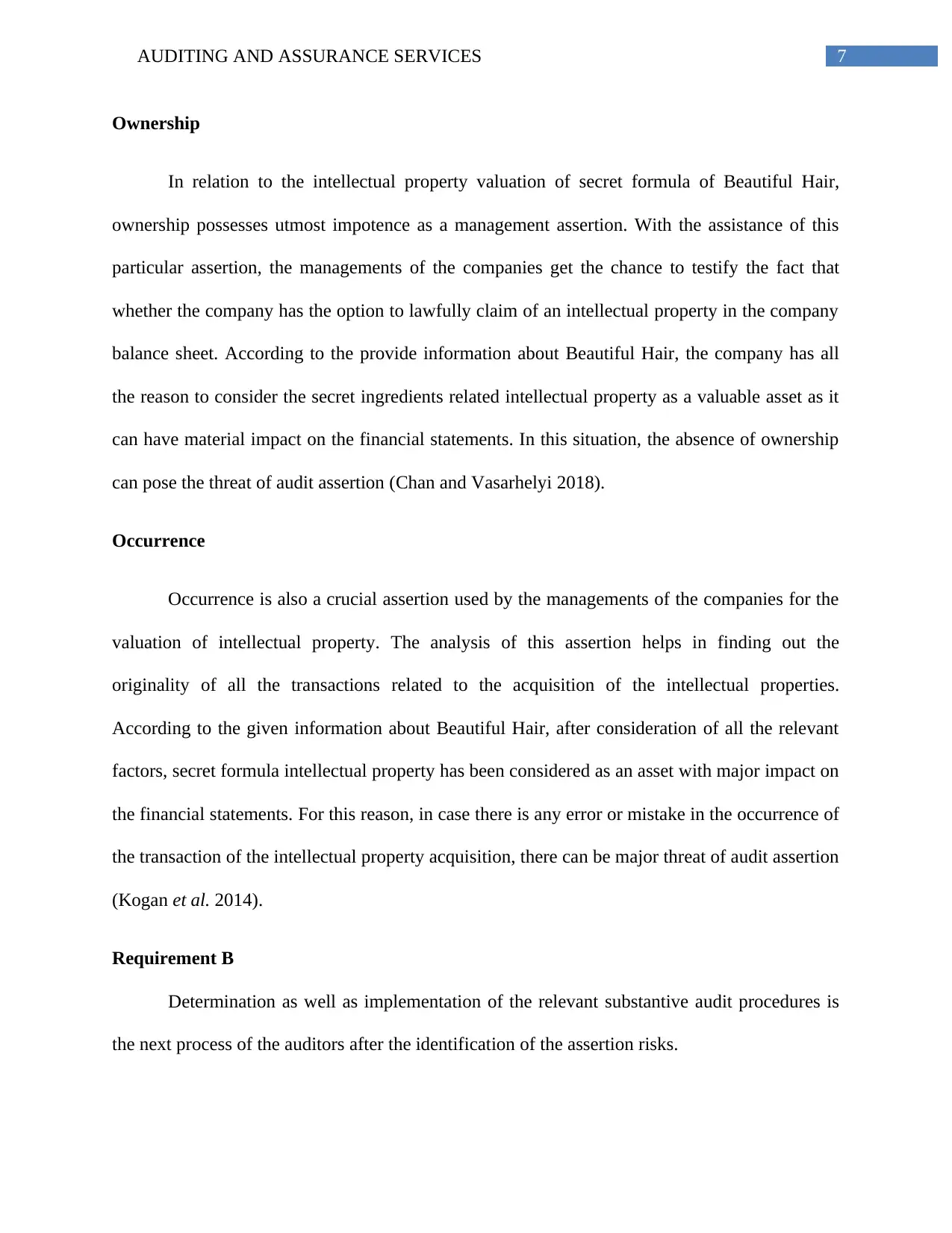
7AUDITING AND ASSURANCE SERVICES
Ownership
In relation to the intellectual property valuation of secret formula of Beautiful Hair,
ownership possesses utmost impotence as a management assertion. With the assistance of this
particular assertion, the managements of the companies get the chance to testify the fact that
whether the company has the option to lawfully claim of an intellectual property in the company
balance sheet. According to the provide information about Beautiful Hair, the company has all
the reason to consider the secret ingredients related intellectual property as a valuable asset as it
can have material impact on the financial statements. In this situation, the absence of ownership
can pose the threat of audit assertion (Chan and Vasarhelyi 2018).
Occurrence
Occurrence is also a crucial assertion used by the managements of the companies for the
valuation of intellectual property. The analysis of this assertion helps in finding out the
originality of all the transactions related to the acquisition of the intellectual properties.
According to the given information about Beautiful Hair, after consideration of all the relevant
factors, secret formula intellectual property has been considered as an asset with major impact on
the financial statements. For this reason, in case there is any error or mistake in the occurrence of
the transaction of the intellectual property acquisition, there can be major threat of audit assertion
(Kogan et al. 2014).
Requirement B
Determination as well as implementation of the relevant substantive audit procedures is
the next process of the auditors after the identification of the assertion risks.
Ownership
In relation to the intellectual property valuation of secret formula of Beautiful Hair,
ownership possesses utmost impotence as a management assertion. With the assistance of this
particular assertion, the managements of the companies get the chance to testify the fact that
whether the company has the option to lawfully claim of an intellectual property in the company
balance sheet. According to the provide information about Beautiful Hair, the company has all
the reason to consider the secret ingredients related intellectual property as a valuable asset as it
can have material impact on the financial statements. In this situation, the absence of ownership
can pose the threat of audit assertion (Chan and Vasarhelyi 2018).
Occurrence
Occurrence is also a crucial assertion used by the managements of the companies for the
valuation of intellectual property. The analysis of this assertion helps in finding out the
originality of all the transactions related to the acquisition of the intellectual properties.
According to the given information about Beautiful Hair, after consideration of all the relevant
factors, secret formula intellectual property has been considered as an asset with major impact on
the financial statements. For this reason, in case there is any error or mistake in the occurrence of
the transaction of the intellectual property acquisition, there can be major threat of audit assertion
(Kogan et al. 2014).
Requirement B
Determination as well as implementation of the relevant substantive audit procedures is
the next process of the auditors after the identification of the assertion risks.
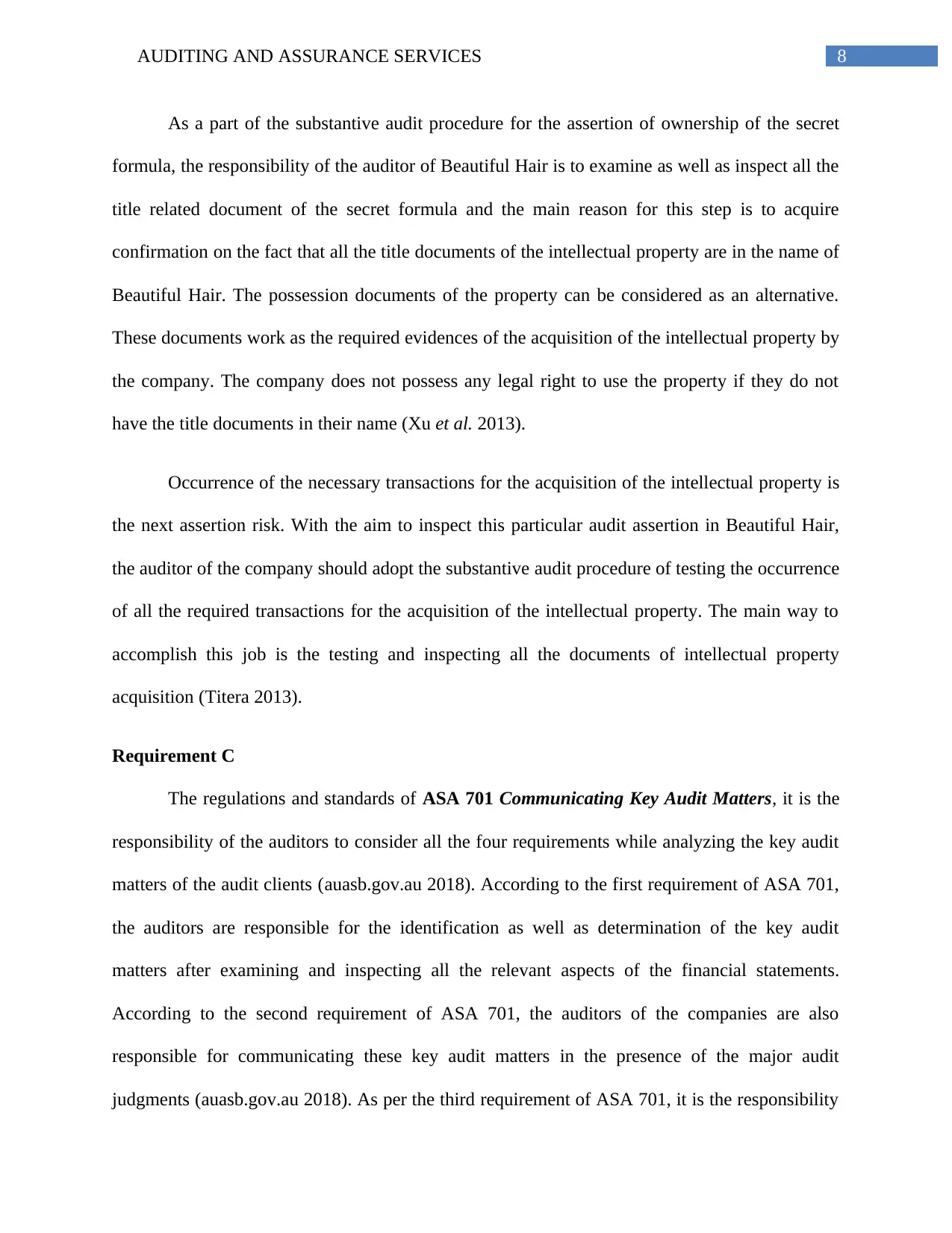
8AUDITING AND ASSURANCE SERVICES
As a part of the substantive audit procedure for the assertion of ownership of the secret
formula, the responsibility of the auditor of Beautiful Hair is to examine as well as inspect all the
title related document of the secret formula and the main reason for this step is to acquire
confirmation on the fact that all the title documents of the intellectual property are in the name of
Beautiful Hair. The possession documents of the property can be considered as an alternative.
These documents work as the required evidences of the acquisition of the intellectual property by
the company. The company does not possess any legal right to use the property if they do not
have the title documents in their name (Xu et al. 2013).
Occurrence of the necessary transactions for the acquisition of the intellectual property is
the next assertion risk. With the aim to inspect this particular audit assertion in Beautiful Hair,
the auditor of the company should adopt the substantive audit procedure of testing the occurrence
of all the required transactions for the acquisition of the intellectual property. The main way to
accomplish this job is the testing and inspecting all the documents of intellectual property
acquisition (Titera 2013).
Requirement C
The regulations and standards of ASA 701 Communicating Key Audit Matters, it is the
responsibility of the auditors to consider all the four requirements while analyzing the key audit
matters of the audit clients (auasb.gov.au 2018). According to the first requirement of ASA 701,
the auditors are responsible for the identification as well as determination of the key audit
matters after examining and inspecting all the relevant aspects of the financial statements.
According to the second requirement of ASA 701, the auditors of the companies are also
responsible for communicating these key audit matters in the presence of the major audit
judgments (auasb.gov.au 2018). As per the third requirement of ASA 701, it is the responsibility
As a part of the substantive audit procedure for the assertion of ownership of the secret
formula, the responsibility of the auditor of Beautiful Hair is to examine as well as inspect all the
title related document of the secret formula and the main reason for this step is to acquire
confirmation on the fact that all the title documents of the intellectual property are in the name of
Beautiful Hair. The possession documents of the property can be considered as an alternative.
These documents work as the required evidences of the acquisition of the intellectual property by
the company. The company does not possess any legal right to use the property if they do not
have the title documents in their name (Xu et al. 2013).
Occurrence of the necessary transactions for the acquisition of the intellectual property is
the next assertion risk. With the aim to inspect this particular audit assertion in Beautiful Hair,
the auditor of the company should adopt the substantive audit procedure of testing the occurrence
of all the required transactions for the acquisition of the intellectual property. The main way to
accomplish this job is the testing and inspecting all the documents of intellectual property
acquisition (Titera 2013).
Requirement C
The regulations and standards of ASA 701 Communicating Key Audit Matters, it is the
responsibility of the auditors to consider all the four requirements while analyzing the key audit
matters of the audit clients (auasb.gov.au 2018). According to the first requirement of ASA 701,
the auditors are responsible for the identification as well as determination of the key audit
matters after examining and inspecting all the relevant aspects of the financial statements.
According to the second requirement of ASA 701, the auditors of the companies are also
responsible for communicating these key audit matters in the presence of the major audit
judgments (auasb.gov.au 2018). As per the third requirement of ASA 701, it is the responsibility
⊘ This is a preview!⊘
Do you want full access?
Subscribe today to unlock all pages.

Trusted by 1+ million students worldwide

9AUDITING AND ASSURANCE SERVICES
of the auditors to ensure the proper communication of these key audit matters with the
organizations staffs who have the responsibility to ensure proper govern nave within the
organization. As per the last requirement, the auditors are responsible for ensuring proper
documentation of the identified key audit matters (auasb.gov.au 2018).
In the case of Beautiful Hair, the application of the principles and standards states that the
auditor of the company has all the reasons to consider their key assertions risks as the key audit
matters. The main reason that make these incidents as key audit matters is that the intellectual
property is valuable in nature as it has crucial effect on the financial statements of the company.
In addition, in case the company does not consider the reporting of this intellectual property in
the balance sheet, there will be major material impact on the financial position of Beautiful Hair
(Brasel et al. 2016).
According to ASA 701, after the identification of the key audit matters related to the
assertion risks, the requirement for the auditor of Beautiful Hair is to disclose the rationales for
considering these matters as the key audit matters. There are two other factors that the auditor is
needed to consider. First, the auditor is needed to disclose the reasons for considering the facts as
the key audit matters. After that, the auditor is needed to disclose the substantive audit
procedures for minimizing these key audit matters (Carson, Fargher and Zhang 2016).
Conclusion
The above whole discussion shows that the risks in the assertions of the management can
have major material impact on the financial statements of the companies. For this reason, the
requirement for the auditors is to take into consideration the effects of audit assertion risks.
According to the above discussion, the auditors have the certain requirements to follow. The
of the auditors to ensure the proper communication of these key audit matters with the
organizations staffs who have the responsibility to ensure proper govern nave within the
organization. As per the last requirement, the auditors are responsible for ensuring proper
documentation of the identified key audit matters (auasb.gov.au 2018).
In the case of Beautiful Hair, the application of the principles and standards states that the
auditor of the company has all the reasons to consider their key assertions risks as the key audit
matters. The main reason that make these incidents as key audit matters is that the intellectual
property is valuable in nature as it has crucial effect on the financial statements of the company.
In addition, in case the company does not consider the reporting of this intellectual property in
the balance sheet, there will be major material impact on the financial position of Beautiful Hair
(Brasel et al. 2016).
According to ASA 701, after the identification of the key audit matters related to the
assertion risks, the requirement for the auditor of Beautiful Hair is to disclose the rationales for
considering these matters as the key audit matters. There are two other factors that the auditor is
needed to consider. First, the auditor is needed to disclose the reasons for considering the facts as
the key audit matters. After that, the auditor is needed to disclose the substantive audit
procedures for minimizing these key audit matters (Carson, Fargher and Zhang 2016).
Conclusion
The above whole discussion shows that the risks in the assertions of the management can
have major material impact on the financial statements of the companies. For this reason, the
requirement for the auditors is to take into consideration the effects of audit assertion risks.
According to the above discussion, the auditors have the certain requirements to follow. The
Paraphrase This Document
Need a fresh take? Get an instant paraphrase of this document with our AI Paraphraser
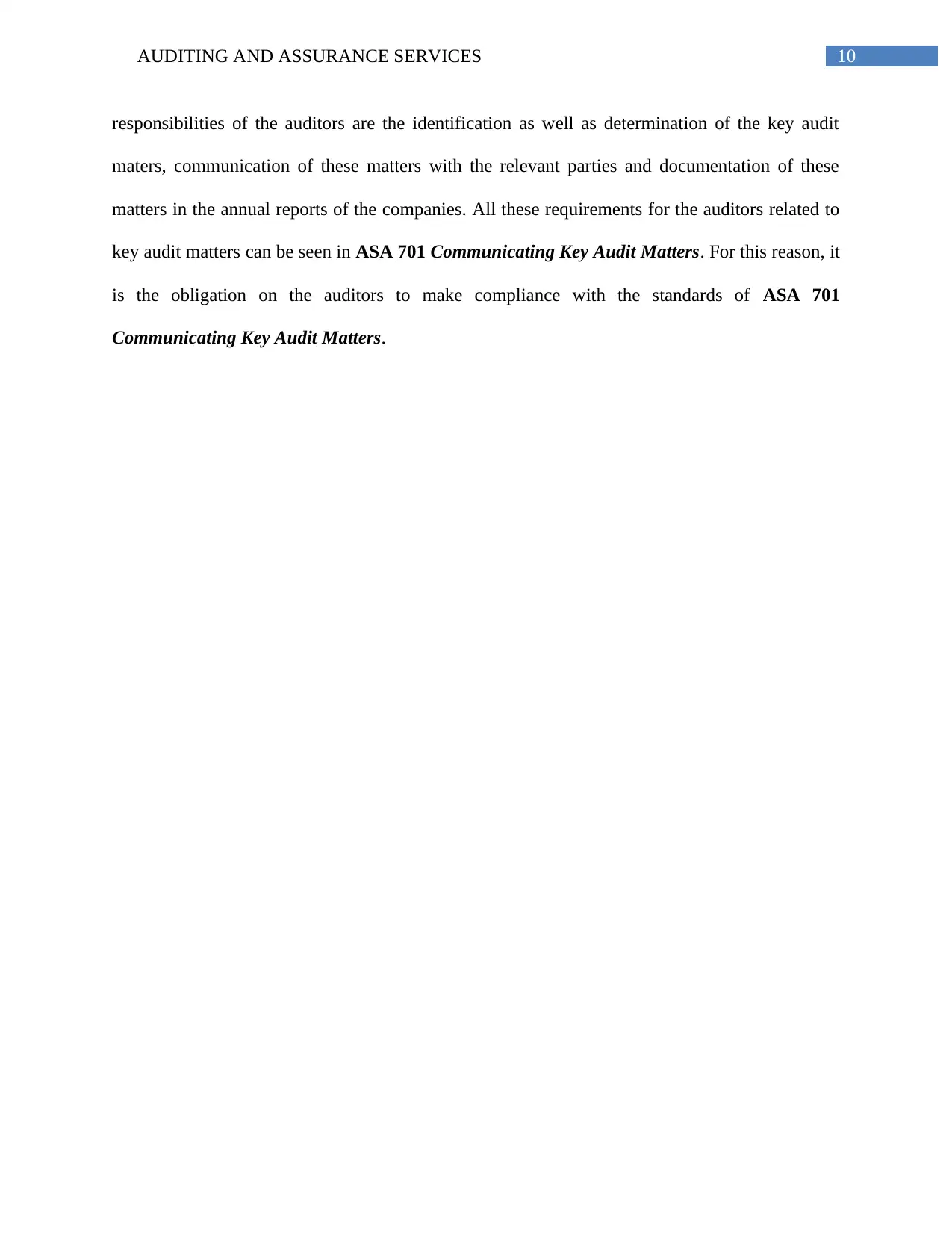
10AUDITING AND ASSURANCE SERVICES
responsibilities of the auditors are the identification as well as determination of the key audit
maters, communication of these matters with the relevant parties and documentation of these
matters in the annual reports of the companies. All these requirements for the auditors related to
key audit matters can be seen in ASA 701 Communicating Key Audit Matters. For this reason, it
is the obligation on the auditors to make compliance with the standards of ASA 701
Communicating Key Audit Matters.
responsibilities of the auditors are the identification as well as determination of the key audit
maters, communication of these matters with the relevant parties and documentation of these
matters in the annual reports of the companies. All these requirements for the auditors related to
key audit matters can be seen in ASA 701 Communicating Key Audit Matters. For this reason, it
is the obligation on the auditors to make compliance with the standards of ASA 701
Communicating Key Audit Matters.
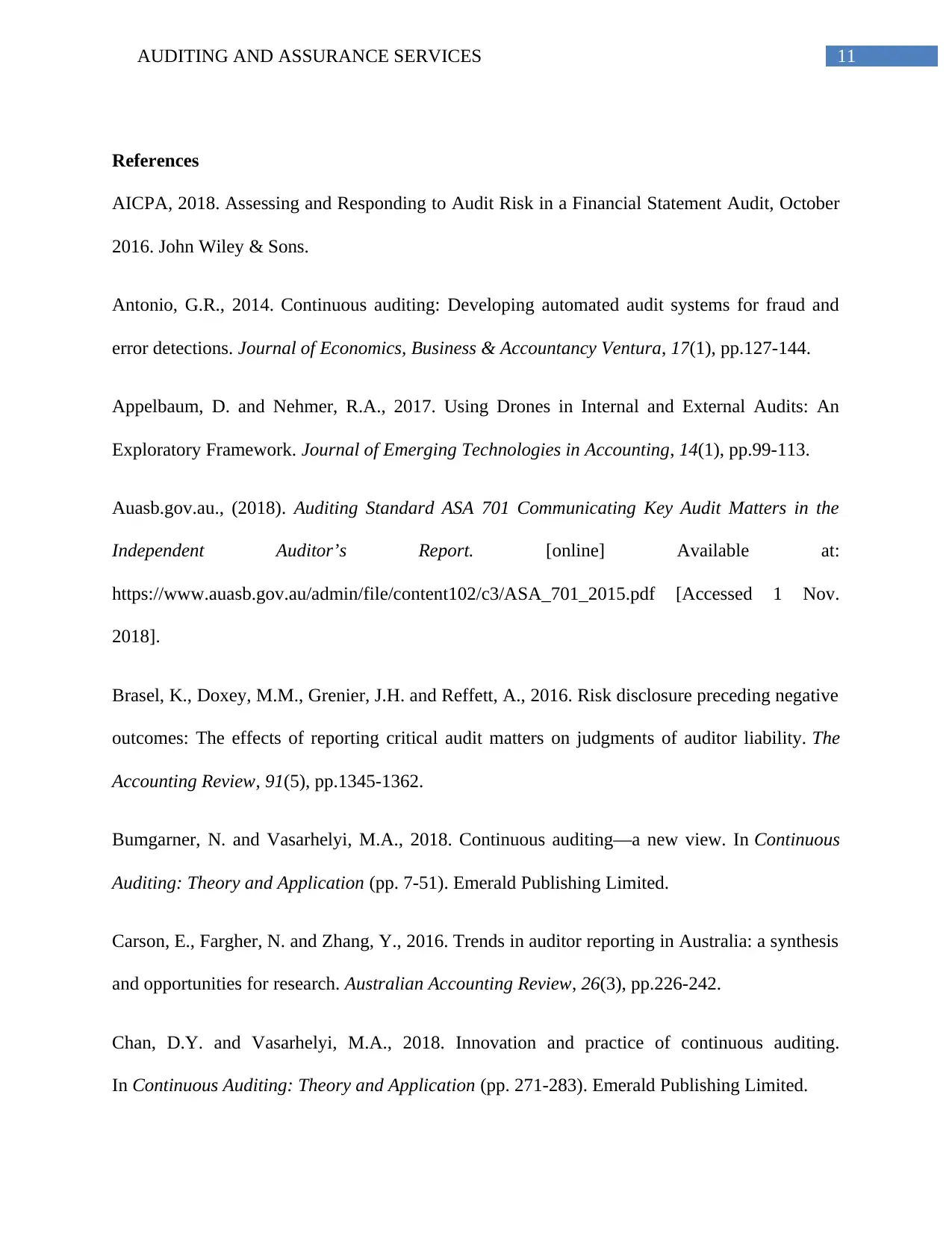
11AUDITING AND ASSURANCE SERVICES
References
AICPA, 2018. Assessing and Responding to Audit Risk in a Financial Statement Audit, October
2016. John Wiley & Sons.
Antonio, G.R., 2014. Continuous auditing: Developing automated audit systems for fraud and
error detections. Journal of Economics, Business & Accountancy Ventura, 17(1), pp.127-144.
Appelbaum, D. and Nehmer, R.A., 2017. Using Drones in Internal and External Audits: An
Exploratory Framework. Journal of Emerging Technologies in Accounting, 14(1), pp.99-113.
Auasb.gov.au., (2018). Auditing Standard ASA 701 Communicating Key Audit Matters in the
Independent Auditor’s Report. [online] Available at:
https://www.auasb.gov.au/admin/file/content102/c3/ASA_701_2015.pdf [Accessed 1 Nov.
2018].
Brasel, K., Doxey, M.M., Grenier, J.H. and Reffett, A., 2016. Risk disclosure preceding negative
outcomes: The effects of reporting critical audit matters on judgments of auditor liability. The
Accounting Review, 91(5), pp.1345-1362.
Bumgarner, N. and Vasarhelyi, M.A., 2018. Continuous auditing—a new view. In Continuous
Auditing: Theory and Application (pp. 7-51). Emerald Publishing Limited.
Carson, E., Fargher, N. and Zhang, Y., 2016. Trends in auditor reporting in Australia: a synthesis
and opportunities for research. Australian Accounting Review, 26(3), pp.226-242.
Chan, D.Y. and Vasarhelyi, M.A., 2018. Innovation and practice of continuous auditing.
In Continuous Auditing: Theory and Application (pp. 271-283). Emerald Publishing Limited.
References
AICPA, 2018. Assessing and Responding to Audit Risk in a Financial Statement Audit, October
2016. John Wiley & Sons.
Antonio, G.R., 2014. Continuous auditing: Developing automated audit systems for fraud and
error detections. Journal of Economics, Business & Accountancy Ventura, 17(1), pp.127-144.
Appelbaum, D. and Nehmer, R.A., 2017. Using Drones in Internal and External Audits: An
Exploratory Framework. Journal of Emerging Technologies in Accounting, 14(1), pp.99-113.
Auasb.gov.au., (2018). Auditing Standard ASA 701 Communicating Key Audit Matters in the
Independent Auditor’s Report. [online] Available at:
https://www.auasb.gov.au/admin/file/content102/c3/ASA_701_2015.pdf [Accessed 1 Nov.
2018].
Brasel, K., Doxey, M.M., Grenier, J.H. and Reffett, A., 2016. Risk disclosure preceding negative
outcomes: The effects of reporting critical audit matters on judgments of auditor liability. The
Accounting Review, 91(5), pp.1345-1362.
Bumgarner, N. and Vasarhelyi, M.A., 2018. Continuous auditing—a new view. In Continuous
Auditing: Theory and Application (pp. 7-51). Emerald Publishing Limited.
Carson, E., Fargher, N. and Zhang, Y., 2016. Trends in auditor reporting in Australia: a synthesis
and opportunities for research. Australian Accounting Review, 26(3), pp.226-242.
Chan, D.Y. and Vasarhelyi, M.A., 2018. Innovation and practice of continuous auditing.
In Continuous Auditing: Theory and Application (pp. 271-283). Emerald Publishing Limited.
⊘ This is a preview!⊘
Do you want full access?
Subscribe today to unlock all pages.

Trusted by 1+ million students worldwide
1 out of 13
Related Documents
Your All-in-One AI-Powered Toolkit for Academic Success.
+13062052269
info@desklib.com
Available 24*7 on WhatsApp / Email
![[object Object]](/_next/static/media/star-bottom.7253800d.svg)
Unlock your academic potential
Copyright © 2020–2025 A2Z Services. All Rights Reserved. Developed and managed by ZUCOL.



